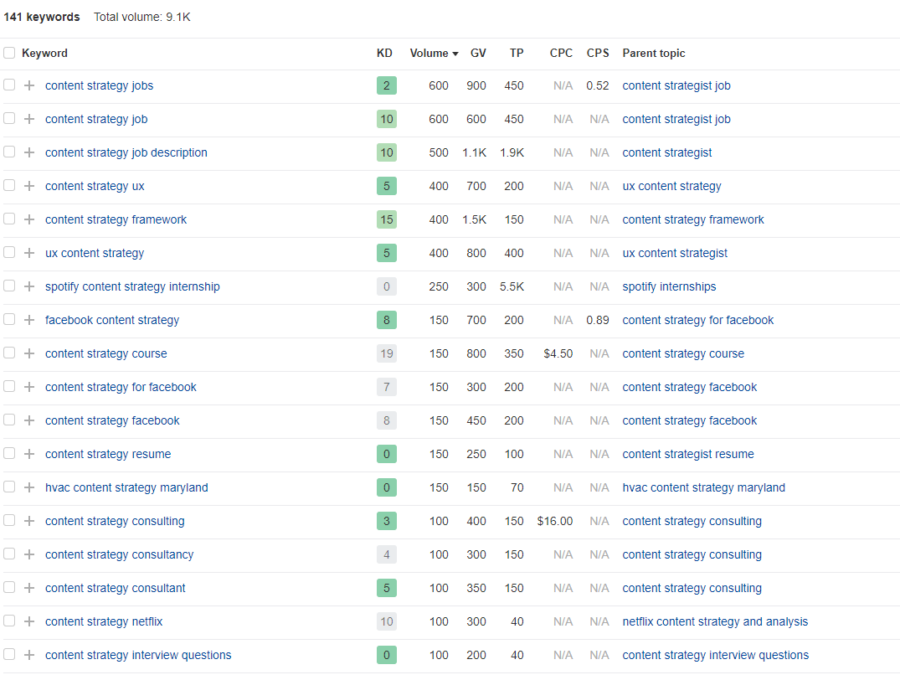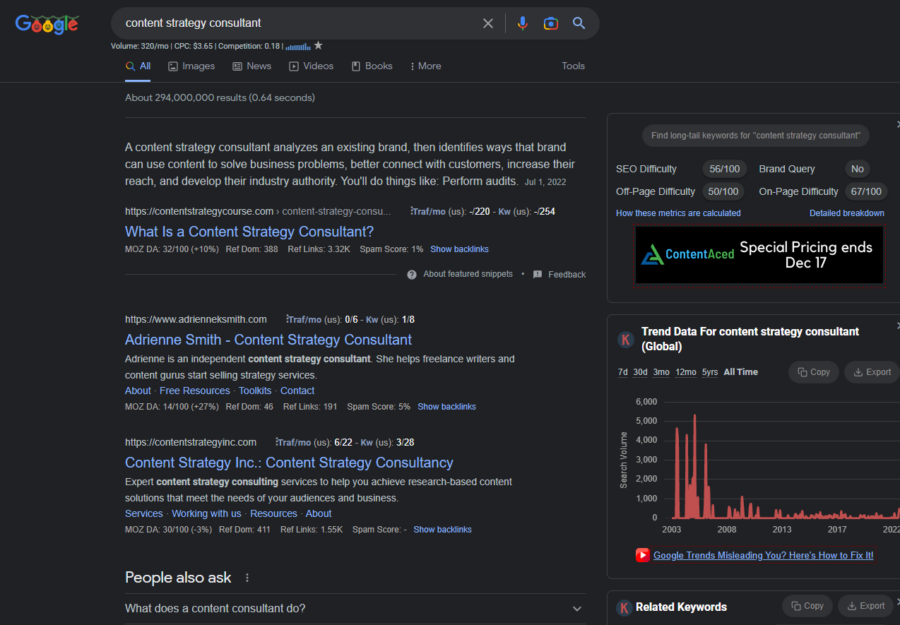Keyword Research Case Studies: Ownership Campaigns
I’d wrapped the core part of the SEO for Non-Scumbags series by poisoning the idea of content-creation-as-art with art’s natural, mortal enemy: ROI. For this reason, I thought folks might not take me up on my tepid call to action of “I may do more stuff, if anyone wants.”
Turns out, against all odds, some of you do want.
So I’m going to make that happen, both to give the people what they want and also to opportunistically teach some of our staff to do keyword research. Toward that latter end, I’ll structure this as an appendix to the original content, with shorter vignettes corresponding to specific keyword research tactics.
Today, I’ll do the most straightforward one: ownership campaigns.

Ownership Campaigns: A Quick Definition
If you were completely new to the concept of keyword research, ownership is probably what you’d do. “Ownership” is shorthand for “term ownership,” and it means identifying keywords that you “should” own (rank for) and going after them. For anyone old enough to get the reference, I also think of these as “yellow pages” terms, since businesses tend to want to own terms that describe the business and its value proposition.
To make this concrete, consider Tricentis, who makes a series of automated testing tools. They would, understandably, want to show up when people google things like, well, automated testing tools. So, given that they want to own the term, they decide to create content with the right search intent for a search about automated testing tools.
They look to own this term and terms like it. And they’ll do that through a combination of directly targeting those terms and also creating related content that targets related or longer tail keywords.
The Broader Goal of an Ownership Campaign
Alright, so why do this? I mean, beyond the general idea of “it’s good to show up in search for the thing you are.” What specific digital marketing box does this check?
If you’re efficiently executing an ownership campaign, you notch three parallel wins:
- You create brand awareness with highly relevant term association.
- You have relevant content with multiple possible distribution channels, including search engines.
- And you build topical authority that lets you punch above your weight for the terms you want to own.
To understand what’s going on here, recall the idea of “commercial” search intent from the search psychology chapter. Searchers with commercial intent are contemplating a purchase or adoption, and they’ll often google around to research players and competitors in the space when in this mode. Searchers with commercial intent want to know what credible options they have.

Ownership campaigns are thus, at their core, about showing up prominently for searchers in that mindset.
Let’s go back to the Tricentis example to help turn our goal abstractions into concretion.
- Create brand awareness by showing up in all kinds of SERPs related to test automation.
- Earn (and potentially pixel) readers by creating content relevant to test automation.
- By having a lot of test automation content on their site, make it more likely for a given marginal article about test automation to rank.
In summary, they’ll create a lot of content about test automation and related topics in order to acquire readers directly with the content, bolster the odds of ranking across the board, and link and buoy their commercial landing pages for commercial searches.
How to Do the Keyword Research
For my money, ownership campaigns have the distinction of being dead easiest to research. (As an aside, this is why they generally form the sum total, alpha, and omega of the research that SEO consultants do.)
Define Seed Terms
You’re going to start with two potential sources of “seed” terms and then riff on them. Those sources are:
- Ask the client (or yourself) what terms they want to be associated with.
- Scrape the client’s (or your) most prominent landing pages, looking for terms of art.
This is easiest to do when the client has offerings that are easy to define, such as Hit Subscribe and, say, “developer marketing” which I’d want to rank for if I wanted to show up in commercial searches. (I don’t want that sort of lead flow for Hit Subscribe, but the why of that is a topic for another day.)
This is harder with a business like one of our clients, Architect, who is defining a category. In this situation, you can see the list with terms you lift from platform, product, or use case pages, such as assuming they’d want to rank for environment provisioning.
Build Lists of Topics Using Seed Terms
Let’s use Hit Subscribe as a concrete example and ignore the fact that I wouldn’t want to actually execute this strategy. Just riffing off the cuff about how I’d explain Hit Subscribe to prospects or just people at a cocktail party yields terms like:
developer marketing, digital marketing, content marketing, digital marketing strategy, developer marketing strategy, content program, guest contributor program
A quick scrape of the site isn’t super productive, since lead flow isn’t the aim of the site, but it does add a few terms to the list:
content strategy, content roadmapping, technical content strategy, content fulfillment, content consulting
The first thing that I’ll do with those terms is dump them into our model, adding volume figures, difficulty scores, Hit Subscribe’s domain authority, and noting any parent keywords.

Doing this puts our keywords into three loose categories, only two of which interest us:
- No or minimal volume
- Volume, but unwinnable
- Volume and winnable.
Looking at this list, we have 4 terms that fall into category (3): developer marketing, developer marketing strategy, content fulfillment, and content consulting.
We’ll put those into the maybe pile and move on, for example purposes. I should note that you could always stop here, if the goal were just 4 posts (well, probably 3, but we’ll get to that). But you’ll usually want more than just 4 posts.
Add to the List with Longer Tails and Related Terms
To keep adding to the list and building topical authority, let’s look at one of the unwinnable terms with volume: content strategy. The essence of ownership is building topical authority. And you build topical authority by answering questions (targeting keywords) related to the core topic.
So we need to figure out terms we can target that relate to content strategy, even though the head term is unwinnable. I generally think of this as “surrounding” the topic. Let’s do a quick matching terms search in ahrefs.

Yikes. The only winnable terms here seem to have a job search intent.
Somehow I’m not shocked that terms related to content strategy are super competitive. It’s almost like everyone in “content strategy” has the same “strategy” (and we all know what I think of that).
Let’s filter by terms that are winnable for hitsubscribe.com, by capping difficulty at 20.

Now we’re getting somewhere. I’m going to add some terms to the base, and here’s what that looks like.

A few things to note here. First, looking at that projected traffic, if we bang out 10 posts or whatever, it looks like we can count on 2K visitors per month to that content (and this is a fairly pessimistic estimate).
Second, all of these terms have the parent term “content strategy” in the mix. That ensures that we’re building topical authority should we ever pursue the head term, “content strategy,” itself.
And finally, some of them have a synonym listed. This is important because it means you wouldn’t individually target all of the terms. Target one and rank, and you also rank for the synonym.
Cull the List Based on Qualitative Concerns
This is a nice start, but we’re not ready to take metaphorical pen to metaphorical paper just yet (or have ChatGPT do it, or whatever). These terms make quantitative sense, but we need to check on the qualitative.
To understand why, look at this SERP as of the time of writing.

What’s going on in this SERP? Well, the featured snippet answers the question “what is a content strategy consultant,” but then you have a bunch of landing pages for content strategy consulting.
This is what we call a fragmented SERP, and it means that different searchers are asking wildly different questions here. Some want a definition, others just want to hire a consultant, like Adrienne there (who has a really smart brand awareness play right there).
This means that targeting “content strategy consultant” with a blog post is a pretty fraught idea. You’d really want to target that term with a landing page rather than a blog post.
Here are checks we should execute on all of the keywords:
- If we’re planning blog posts, does this term have a research intent?
- Does the term cannibalize other terms in the list (i.e. synonyms)?
- What questions do searchers seem to be asking, and is it reasonable for our site to answer those questions (e.g. this is why I don’t bother with the job-related searches)?
- Could we rank for any parent-child combos in a single post, or should we separate them?
Once you’ve applied those filters to the keywords found, the result is a backlog of topics to brief and create.
Recap and Summary
Let’s assume that we did all of this and did it across the full spectrum of keywords over the course of time, building a significant library with this ownership campaign. Here’s what we would achieve:
- Build a lot of direct, segmented traffic to the website (probably in the 5 figures per month).
- Build a lot of topical authority around topics like digital marketing, content, strategy, and consulting.
- Make it more likely we punch above our weight with desirable, commercial head terms.
- Start to have our brand show up in SERPs in a way that establishes credibility.
But ownership campaigns do have some downsides:
- They tend to be the least cost effective and most competitive (because this is what SEO consultants hawk and what everyone does).
- Having extremely beginner content on your site like “what is a content strategy” can be a weird look for a content strategy vendor, if you don’t position it right.
- Ownership campaigns commodify vendors (this is the heart of why I don’t want this traffic to hitsubscribe.com — my management consultant heart cannot bear the commodification).
On balance, ownership campaigns make sense, especially for brands with mass market offerings and for whom commodification is less bug than it is quirk, if not feature. They also tend to create straightforward calls to action on your site, since you’re either going to link to the landing page you’re building around or you’re just going to call for the sale. You don’t need to get creative with mailing lists, webinars, lead magnets, etc.
And, for those of you reading, they tend to be the easiest to grok and reason about. Which is why I started with them. Stay tuned for some more avant garde, less competitive concepts in future episodes.

 @richards
@richards @timstatler
@timstatler @todd
@todd @dert
@dert @themolitor
@themolitor